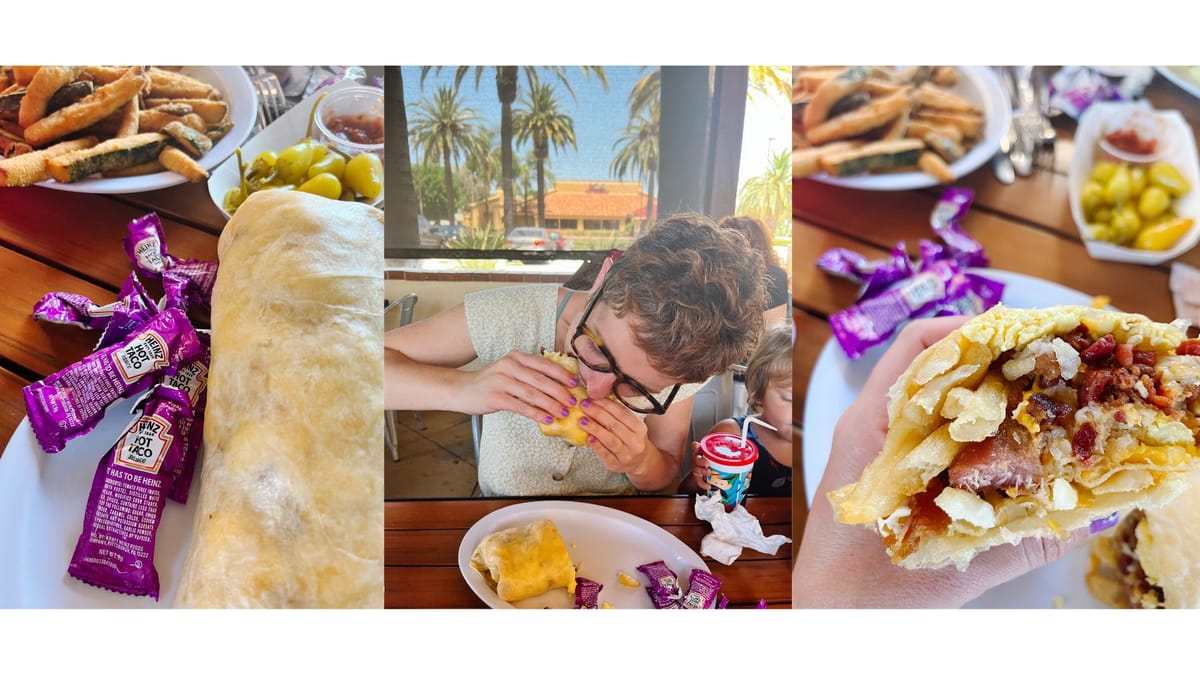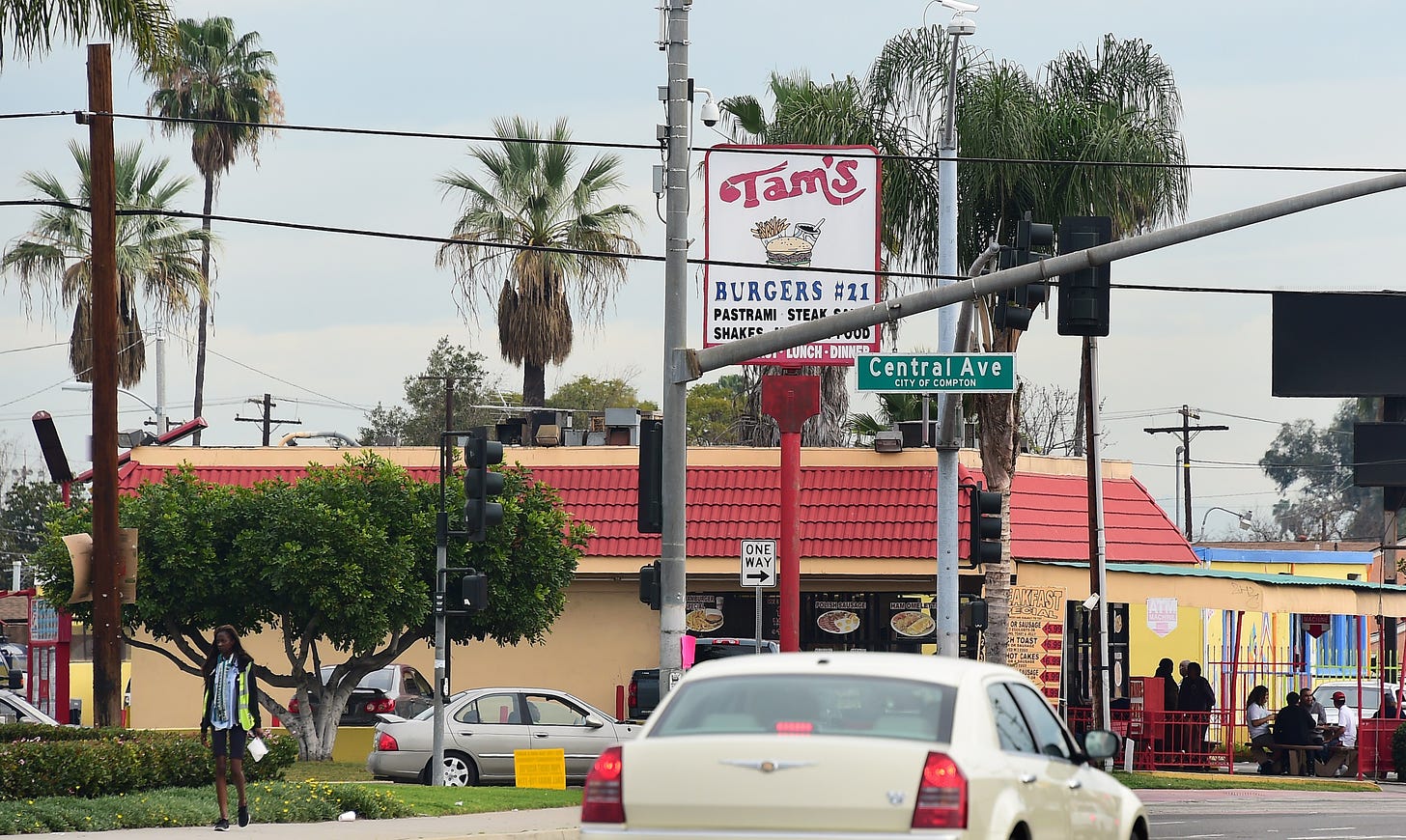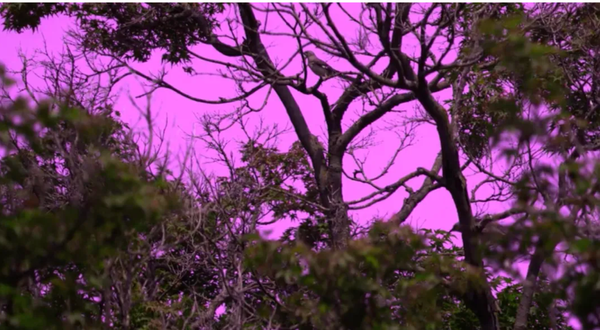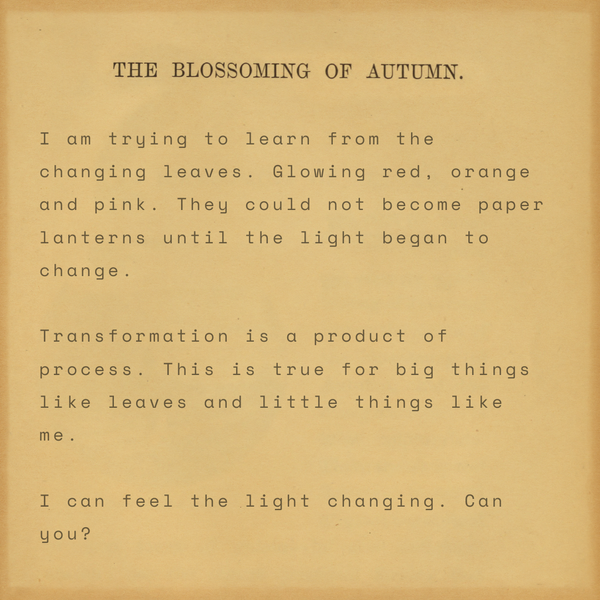The Breakfast Burrito in the Age of Suburbs
Breakfast burritos kept my suburban childhood structurally sound

As a kid, I didn’t know that Orange County, California suburbs were built around redlining and racial covenants. I thought they were built around places that served pastrami and burritos. Every suburb had its own version of the independently owned fast casual pastrami/burger/burrito/gyro restaurant. Those diners kept the suburbs structurally sound. A Chili’s could never bear the weight of a town. I guess I understood as a kid what so many city planners fail to grasp now. Whether in the suburb or the city, people need community specific spaces designed to nourish. Sometimes those spaces are public libraries, sometimes they’re restaurants with great fried zucchini.
Farley Elliot wrote a great piece on the history of this hometown hero for Eater, The Fast-Food Diner Is LA’s True Regional Specialty Restaurant, and It’s All Thanks to Pastrami. Basically, after World War II a combination of suburban growth, redlining, the constant aftershocks of the horrific Japanese internment camps remade neighborhoods in Los Angeles. Many Greek and Jewish restaurant owners picked up their diners - or at least the recipes and the rent - and moved to new communities with their pastrami topped flat top fare.
Elliot writes,
“Around the same time, in the late 1940s and early 1950s, commodity beef and the emergence of Southern California’s famous highway system drew diners to faster service via drive-thrus and walk-up takeaway windows. The first Tommy’s, opened in 1946 by the son of Greek immigrants, helped solidify chili as a staple food and a condiment in Los Angeles, expanding menus to include a chili-over-stuff section that ran from fries and hot dogs to more prevalent Southern California staples like tamales and fast-food burgers.”
My family drove from our Southern California suburb into Los Angeles a lot when I was a kid. My favorite itinerary was -a museum visit - often the LACMA. Early dinner at Canter’s - matzo ball soup and a reuben with a side of fries. Then we’d get ice cream at the Farmer’s Market on 3rd and Fairfax. My order was two scoops of whatever had ribbons of peanut butter in it. I was usually pretty ill by the time we walked out of the market. That was fine, I had the whole car ride home to recover.
We’d drive past CBS Television City. I’d crane my neck to see if I saw anyone I recognized. When I realized That Thing You Do was filmed there, I sorted through the times we’d driven by when it was being filmed. Had I seen Guy Patterson without even realizing it? We’d stop and start our way past Canters, the Fairfax Out of the Closet, Greek diners, kosher bakeries, taco shops, a synagogue, store windows with rows of plastic high heels and bus stops plastered with movie posters. Every building felt connected to the other and to the streets that we followed out of the city.
Driving out of Los Angeles was kind of like driving through circles of a tree. The oldest suburbs were closest to Los Angeles, the tract homes were built in the forties and fifties. As we moved through zip codes, the homes got newer. The sixties, the seventies, the 80s, and then the ones just being built in the 90s. The stores and restaurants I could see from the freeway all seemed to come from the same Community Starter Pack - Border’s, Del Taco, In n Out, Mervyn’s, Blockbuster, Circuit City. None of them felt connected to anything. But I knew if we pulled off and drove into any of those towns, we’d find the unique piece of Los Angeles suburban kids like me got to call their own.
Walter Benjamin said that original works of art have aura. Aura is the artwork’s “presence in time and space, its unique existence at the place where it happens to be.” Reproductions of art, like a postcard of The Birth of Venus, do not have an aura because they are stripped of their cultural context and exist in many spaces. I am not sure what he would have made of the diners repeating across my suburban landscape, but each felt aglow with authenticity to me.

The southern California fast-food diner is often a smallish beige stucco building. Most of them have a sign that looks a lot like the Tam’s #21 sign. The diner building is like a church building, its form conveys its function. It is easy to know the inside from the outside. Covered booths, bolted down tables and brown plastic high chairs stacked in a corner next to the restroom. The menu is always as expansive as the space is cramped. Bacon and eggs, fried zucchini, fried mushrooms, fried everything, pancakes, burgers, pastrami dips, pastrami burgers, breakfast burritos with fries inside instead of hash browns, taquitos and gyro sandwiches.
The diner at the center of my childhood suburb is called Bravo Burgers. When I was a kid, it was in a little beige stucco building. We went as a family for breakfast on Saturdays. When I was in high school, my dad and I started stopping in for a bite mid-week too. High school was difficult for me. My neurodiversity was ever-evident but ever-undiagnosed. There were almost 4,000 kids in my high school. I didn’t know how to be one of them. I read under my desk and failed math tests.
My dad drove me to school every morning. Mostly, he turned into the school drop off and told me he loved me as I heaved my backpack out of his car. But some mornings, after I got in the car he’d say, well in a certain way that made my heart leap. That well meant I was going to miss the first period of school. We were going to get breakfast at Bravo Burgers together.
The owner knew his order - bacon, eggs over easy, hash browns and sourdough toast. They’d talk like people in small towns talk in the movies. Asking about each other’s families, making comments about the season or the news. He’d mention something I was reading or working on and she’d talk to me too. It all made me feel like I was a part of a community. I’d order a breakfast burrito with fries instead of hash browns.
We’d sit down in a booth and wait for our food. Sometimes dad had a newspaper for us to look over. Mostly we talked. About music, the news, books, movies. And, after a few bites of my breakfast burrito, I’d share the bits of my worried life I could put into words. Those booths were the first sanctuary I experienced outside of my family home. When my dad finished his last piece of sourdough toast, it was time to go. I always felt like crying when my dad dropped me off at school. But on Bravo Burger days, I didn’t feel as empty.
I left home at eighteen. And then we didn’t have breakfast together as often. My parents moved away from my hometown a few years later. My dad died when I was twenty-eight. And now we don’t have breakfast together at all. I know that should seem obvious. It’s hard to eat sourdough toast and eggs with a dead person. But there are still some mornings when I remember with a shock that I’ll never slide into a booth across from him again.
Bravo Burgers outgrew its first little beige stucco building.. They moved one strip mall over into an old Burger King. It’s in a brown stucco building now. The booths are bigger. They kept their free chip and salsa bar. I went back to Bravo Burgers a few months after my dad died. The owner smiled and asked what she’d asked every time I walked in alone, “How’s your mom and dad?” I cried when I told her. If I could have, I would have explained that her restaurant is the only place left that still feels like my childhood home. Instead, I ordered my dad’s breakfast.
Whenever I’ve gone back in the years since, she’s been there. I feel such relief every time she recognizes me because it means she remembers my dad. It means someone remembers my dad. He still exists in time and space.
Riley and I took our girls home to Southern California last Christmas. It was the first time we’d been back since the beginning of the pandemic. He and I grew up together. So Bravo Burgers feels like home to him too. We used to eat breakfast burritos together in high school and are now ordering them for our kids. Life is funny. When we walked in, the owner was behind the counter. I didn’t think she’d recognize me behind my mask. But she did.
I ordered my dad’s breakfast with a burrito on the side.
Want to read another piece about suburban foodscapes? Here’s a piece about Grief and Sex at Mimi’s Cafe.




